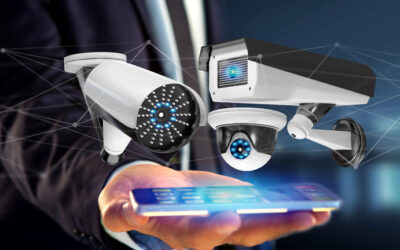Biometric security has emerged as a pivotal solution for businesses seeking robust and reliable security measures. This technology, which includes methods like fingerprint recognition, facial recognition, and iris scans, leverages unique biological traits to verify identity. As traditional security measures such as passwords and key cards often fall short, businesses are turning to biometric systems to mitigate the risks of unauthorised access and fraud.
This article delves into the multifaceted nature of biometric security, aiming to equip business owners and decision-makers with a comprehensive understanding of the technology. We will explore the various types of biometric systems, evaluate their advantages and disadvantages, and provide practical guidance on choosing the right system for your business. Additionally, we will highlight the latest trends and future developments in biometric technology, ensuring you stay informed about advancements that could impact your business operations.
Through this exploration, our goal is to help you navigate the complexities of implementing biometric security in your business, balancing enhanced security with cost-effectiveness, data protection, and a positive user experience.
Understanding Biometric Security
What is Biometric Security?
Biometric security is a cutting-edge method of authentication that uses individuals’ unique biological characteristics to verify their identity. Unlike traditional security measures, such as passwords or PINs, which can be easily compromised, biometric systems rely on intrinsic human traits that are difficult to replicate or forge. This makes biometric security a highly reliable and secure means of protecting sensitive information and access points.
Types of Biometric Systems
Biometric security encompasses various systems, each utilising different biological markers to authenticate users. Here are some of the most common types:
Fingerprint Recognition
Fingerprint recognition involves scanning and analysing the unique patterns of ridges and valleys on an individual’s fingertip. This method is widely used due to its accuracy, ease of use, and relatively low cost. It’s commonly implemented in mobile devices, security checkpoints, and time attendance systems.
Facial Recognition
Facial recognition technology identifies individuals by analysing facial features such as the distance between eyes, nose shape, and jawline. This system is gaining popularity in public safety, access control, and customer identification, offering a contactless and convenient authentication method.
Iris and Retina Scans
These biometric systems examine unique patterns in the eye. Iris scanning involves analysing the coloured ring around the pupil, while retina scanning focuses on the blood vessel patterns in the back of the eye. Both methods are highly accurate and are often used in high-security environments, although they can be more costly and require specialised equipment.
Voice Recognition
Voice recognition uses the unique characteristics of a person’s voice, including pitch, tone, and cadence, to verify identity. This method is useful for telephone banking, customer service, and other applications where voice is the primary means of interaction. While convenient, it can be affected by background noise and changes in the individual’s voice.
Hand Geometry and Vein Recognition
Hand geometry systems measure the shape and size of the hand and fingers, while vein recognition uses infrared light to capture the unique pattern of veins under the skin. These systems are typically used in environments requiring high levels of security, such as laboratories and data centres, offering robust protection against spoofing.
Each of these biometric systems offers unique benefits and challenges, making it essential for businesses to consider their specific security needs and operational environments when choosing the right solution.
The Advantages of Biometric Security in Your Business
Enhanced Security and Accuracy
Biometric security systems offer a significant advantage over traditional methods like passwords or tokens, primarily due to their inherent security and accuracy. Biometric data, such as fingerprints or facial features, are unique to each individual, making them extremely difficult to replicate or forge. Unlike passwords, which can be guessed or stolen, biometric characteristics are nearly impossible to duplicate, ensuring a higher level of security. This makes biometrics particularly effective in preventing unauthorised access and reducing the risk of security breaches.
Improved User Convenience
One of the most appealing aspects of biometric security is the convenience it offers to users. Traditional security measures often require memorising multiple passwords or carrying physical tokens, which can be cumbersome and prone to being forgotten or lost. In contrast, biometric systems streamline access by allowing users to authenticate themselves using innate physical traits. This not only simplifies the user experience but also speeds up the authentication process, enhancing overall efficiency.
Cost Efficiency in the Long Run
While the initial setup costs for biometric systems can be higher than traditional security measures, they often prove to be more cost-effective in the long run. Biometric systems reduce the expenses associated with password management, such as resetting forgotten passwords and maintaining secure password databases. Additionally, the robust security provided by biometrics helps to mitigate the costs linked to security breaches, which can be substantial. By preventing unauthorised access and protecting sensitive data, businesses can avoid costly breaches and associated legal ramifications.
Scalability and Integration
Biometric systems are highly scalable, making them an ideal choice for businesses of all sizes. They can be easily integrated with existing security infrastructures and software, allowing companies to enhance their security measures without overhauling their entire system. This adaptability is particularly valuable in dynamic business environments where security needs may evolve over time. Moreover, the integration capabilities of biometric systems ensure that they can work seamlessly with other security technologies, providing a comprehensive security solution that can grow with the business.
Overall, the advantages of biometric security make it a compelling choice for businesses looking to enhance their security measures while also improving user convenience and cost efficiency.
The Drawbacks of Biometric Security
Initial Costs and Implementation
While biometric security systems offer long-term benefits, the initial costs of implementation can be prohibitive for some businesses. Setting up these systems typically involves significant investment in specialised hardware, such as fingerprint scanners or facial recognition cameras, as well as advanced software for processing and storing biometric data. Additionally, the integration of biometric systems with existing infrastructure may require technical expertise, further increasing the initial expenditure. These upfront costs can be a barrier for smaller businesses or those with limited budgets.
Privacy Concerns
Biometric data, being unique to each individual, is highly sensitive. The collection and storage of such data raise significant privacy concerns, particularly regarding how the data is managed and protected. There are fears that biometric data, if misused or inadequately secured, could lead to privacy violations or identity theft. Businesses must navigate these concerns carefully, ensuring that they comply with data protection regulations and implement robust security measures to safeguard biometric information. Transparent policies and clear communication with users about how their data will be used and protected are crucial in addressing these privacy issues.
Potential for Biometric Data Theft
Despite the enhanced security that biometric systems offer, they are not immune to the risk of data breaches. If compromised, biometric data poses a unique and serious threat because, unlike passwords, biometric traits cannot be easily changed. A breach of this data can have long-lasting consequences, potentially compromising individuals’ identities permanently. The security of biometric systems must therefore be rigorously maintained to prevent unauthorised access and data theft. This includes encrypting data, implementing stringent access controls, and regularly updating security protocols.
Limitations and Reliability Issues
Biometric systems, while advanced, are not without their limitations. Factors such as environmental conditions, user health, and system calibration can affect the accuracy and reliability of biometric authentication. For instance, fingerprint scanners may struggle with wet or dirty fingers, and facial recognition systems might be less effective in poor lighting conditions. Moreover, there is the possibility of false positives (incorrectly granting access) or false negatives (denying access to authorised individuals), which can undermine user trust and system reliability. These issues highlight the need for continuous system improvements and the consideration of backup authentication methods to ensure consistent and accurate security measures.
While biometric security offers many benefits, these drawbacks must be carefully considered and addressed to ensure a balanced and effective security strategy.
Practical Considerations for Businesses
Choosing the Right Biometric System
When selecting a biometric security system, businesses need to consider several critical factors to ensure the chosen solution meets their specific needs. The type of biometric system—whether fingerprint recognition, facial recognition, iris scans, or another form—should align with the security requirements and operational environment of the business. Cost is also a significant consideration; businesses must balance the upfront investment and ongoing maintenance costs with the expected benefits. The scale of implementation is another crucial factor, particularly for larger organisations, where scalability and ease of integration with existing security infrastructure are essential. Finally, businesses should evaluate the system’s compatibility with current technologies and workflows to minimise disruption and facilitate seamless integration.
Legal and Ethical Considerations
The use of biometric data in business settings is subject to various legal and ethical considerations. Regulatory frameworks governing data protection, such as the Australian Privacy Principles (APPs), require businesses to handle biometric information responsibly, ensuring it is collected, stored, and processed in a manner that protects individuals’ privacy. Companies must obtain explicit consent from users before collecting their biometric data and clearly communicate the purpose and scope of data usage. Ethical issues, including potential biases in biometric systems and the implications for personal privacy, must also be addressed. Businesses need to implement transparent practices and robust data protection measures to maintain trust and comply with legal obligations.
Training and User Adoption
The successful implementation of biometric security systems hinges on user acceptance and proper training. Employees and users must understand how the systems work, the benefits they offer, and how to use them correctly. Comprehensive training programs are essential to educate staff about the new technology, address any concerns, and ensure smooth adoption. This includes training on troubleshooting common issues, understanding privacy considerations, and maintaining the systems. User adoption can be enhanced by clearly communicating the advantages of biometrics, such as improved security and convenience, and ensuring that the systems are user-friendly and accessible.
Future Trends in Biometric Security
The field of biometric security is rapidly evolving, with emerging technologies promising to enhance the effectiveness and reliability of these systems. One notable trend is the integration of artificial intelligence (AI) and machine learning, which can improve the accuracy of biometric systems and reduce instances of false positives and negatives. Advances in data encryption and secure storage solutions are also critical, as they help protect sensitive biometric data from breaches and unauthorised access. Additionally, multi-modal biometrics, which combine multiple biometric identifiers (such as fingerprint and facial recognition), are gaining traction for providing enhanced security. Businesses should stay informed about these developments to ensure their security infrastructure remains robust and up-to-date.
Incorporating these practical considerations can help businesses implement biometric security systems that are not only effective and secure but also compliant with legal standards and acceptable to users.
Key Takeaways
Biometric security systems offer a robust solution for enhancing business security, leveraging unique biological traits to prevent unauthorised access. The primary advantages include heightened security and accuracy, improved user convenience, and potential cost savings over time. These systems also offer scalability and easy integration with existing infrastructure, making them suitable for businesses of various sizes.
However, businesses must consider the drawbacks, such as the high initial costs and implementation challenges. Privacy concerns and the risk of biometric data theft necessitate stringent data protection measures. Additionally, limitations and reliability issues, such as false positives and environmental sensitivity, must be addressed to maintain system integrity.
For businesses considering the adoption of biometric security, here are some actionable steps:
- Assess Security Needs: Evaluate your business’s specific security requirements and operational environment to choose the most suitable type of biometric system.
- Budget Planning: Consider the total cost of ownership, including initial setup, maintenance, and potential upgrades. Factor in savings from reduced password management costs and enhanced security against breaches.
- Ensure Compliance: Stay informed about relevant data protection laws and regulations. Implement policies to safeguard biometric data, ensuring transparency and user consent.
- Focus on User Adoption: Invest in training and communication to facilitate user acceptance and proper use of the new systems. Highlight the benefits and address any concerns related to privacy and system reliability.
- Stay Informed: Keep abreast of technological advancements and trends in biometric security. This includes exploring innovations in AI, encryption, and multi-modal systems to future-proof your security infrastructure.
By carefully weighing the pros and cons and taking these steps, businesses can effectively implement biometric security systems that enhance protection while addressing ethical and practical considerations.
FAQs
1. What is biometric security and how does it work?
Biometric security uses unique biological characteristics such as fingerprints, facial features, or voice patterns to verify an individual’s identity. These traits are scanned and compared against stored data to grant or deny access.
2. What types of biometric systems are available for businesses?
Common types include fingerprint recognition, facial recognition, iris and retina scans, voice recognition, and hand geometry or vein recognition. Each system has its own set of advantages and use cases.
3. What are the main benefits of using biometric security in a business setting?
Benefits include enhanced security due to the difficulty of replicating biometric traits, improved user convenience by eliminating the need for passwords, and long-term cost savings from reduced management of traditional security systems.
4. What are some potential drawbacks of biometric security systems?
Drawbacks include high initial setup costs, privacy concerns over the handling of sensitive biometric data, the risk of data breaches, and potential reliability issues under certain conditions (e.g., wet fingers, poor lighting).
5. How can businesses ensure the security of biometric data?
Businesses should implement strong encryption, access controls, and regular security audits. They should also comply with relevant data protection regulations and clearly communicate data usage policies to users.
6. Are biometric security systems cost-effective for small businesses?
While the initial costs can be high, biometric systems can be cost-effective over time by reducing the expenses associated with managing passwords and enhancing overall security, thereby avoiding costly breaches.
7. How do legal regulations impact the use of biometric security in businesses?
Regulations such as data protection laws require businesses to handle biometric data responsibly, including obtaining explicit consent, safeguarding the data, and being transparent about its use. Non-compliance can lead to legal penalties.
8. What should businesses consider when choosing a biometric security system?
Factors to consider include the specific security needs, the type of biometric technology that best suits the operational environment, budget constraints, scalability, and compatibility with existing systems.
9. Can biometric systems be integrated with other security measures?
Yes, biometric systems can be integrated with traditional security measures like PINs or access cards to create a multi-factor authentication system, enhancing overall security.
10. What future trends should businesses watch in biometric security?
Key trends include the integration of AI and machine learning for improved accuracy, advancements in data encryption and secure storage, and the development of multi-modal biometric systems that combine multiple biometric traits for better security.
Conclusion
Implementing biometric security in your business is a significant decision that requires careful consideration of both its advantages and potential drawbacks. While these systems offer enhanced security, convenience, and long-term cost efficiency, they also come with initial costs, privacy concerns, and potential reliability issues. Businesses must weigh these factors to determine whether biometric security aligns with their specific needs and capabilities.
Staying informed about the latest developments in biometric technology is crucial. As the field evolves, new innovations and best practices emerge, offering more robust and secure solutions. Businesses should continuously evaluate their security measures, adapting to advancements and changing regulatory landscapes to ensure their systems remain effective and compliant.
In embracing biometric security, businesses can not only enhance their protection against unauthorised access and data breaches but also improve the overall user experience. However, this journey requires a proactive approach, balancing technological adoption with ethical considerations and user trust.




